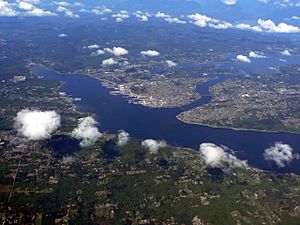Sinclair Inlet facts for kids
Sinclair Inlet is a shallow arm of the sea, also called an embayment, located in the western part of Puget Sound in Kitsap County, Washington, USA. It is about 20 meters deep at its deepest point. This inlet is connected to Port Orchard and touches the edges of three cities: Bremerton, Bainbridge Island, and Port Orchard. It links to Dyes Inlet through the Port Washington Narrows and to the wider Puget Sound through Rich Passage. The inlet was named by United States Navy explorer Charles Wilkes after George T. Sinclair, who was part of his ship's crew. The Puget Sound Naval Shipyard, a large Navy base, is found on the north side of Sinclair Inlet.
Contents
What Lives in Sinclair Inlet?
More than 20 streams flow into Sinclair Inlet. The biggest ones are Gorst, Blackjack, Anderson, and Wright Creeks. The inlet itself is shaped like a triangle, about 1.9 kilometers (1.2 miles) wide and 6.4 kilometers (4 miles) long. Its waters are mostly salty and are strongly affected by the ocean's tides.
Many types of salmon live in Sinclair Inlet and its streams. Gorst Creek and Blackjack Creek are especially important because Chinook salmon come here to lay their eggs. In 2002, over 17,000 Chinook salmon were found in the inlet, and another 10,000 adult salmon swam into Gorst Creek. Other salmon species, like coho and chum, also use Sinclair Inlet and its nearby streams.
Protecting the Environment
Over time, human activities have changed Sinclair Inlet quite a bit. Areas of shallow water, which are important habitats for many creatures, have been changed or lost. The plants and trees along the shoreline have also decreased. Because of these changes, the quality of the water and the mud at the bottom of the inlet has gone down.
Cleaning Up the Water
In the 1980s, scientists found high levels of certain chemicals in the mud at the bottom of Sinclair Inlet. These chemicals included polychlorinated biphenyls (PCBs). In 1996, a study was done around the naval base in Bremerton to figure out how to clean up the area. The main goal was to make sure that fish living on the bottom of the inlet were safe for people to eat.
Sinclair Inlet has also been a focus for cleaning up mercury pollution. Years of activity at the naval shipyard caused mercury to build up in the area. The highest amounts of mercury were found in the mud from around World War II. After the war, mercury levels slowly went down. This was thanks to better ways of handling metals and new rules to protect the environment. However, the mercury levels have dropped slowly because the mud builds up very slowly in the inlet.
From 2000 to 2001, a process called "remedial dredging" was used to clean up the polluted areas. This involved carefully removing the contaminated mud from the bottom. This cleanup effort had a good effect on the inlet. Even so, the amount of mercury in the water of Sinclair Inlet is still about three times higher than in the central part of Puget Sound.
Protecting Against Pollution
In January 2017, the Suquamish Tribe, along with environmental groups, raised concerns about the U.S. Navy. They were worried because the Navy had scraped paint and other materials off the hull (bottom) of an aircraft carrier, the USS Independence (CV-62), while it was in Sinclair Inlet. This was done without the right permission from the United States Environmental Protection Agency. The tribe believed that a large amount of material was removed during this scraping.
In January 2020, the Navy and the tribe reached an agreement. The Navy agreed to cover the area where the ship was docked with a layer of sand at least 10 centimeters (about 4 inches) thick. This agreement also included a rule that the Navy would not scrape ship hulls in the inlet for 10 years. This is important because harmful pollutants, like copper and zinc, can be scraped into the water. This agreement is especially important because there are plans to scrape the hull of another ship, the USS Kitty Hawk, in the future.


